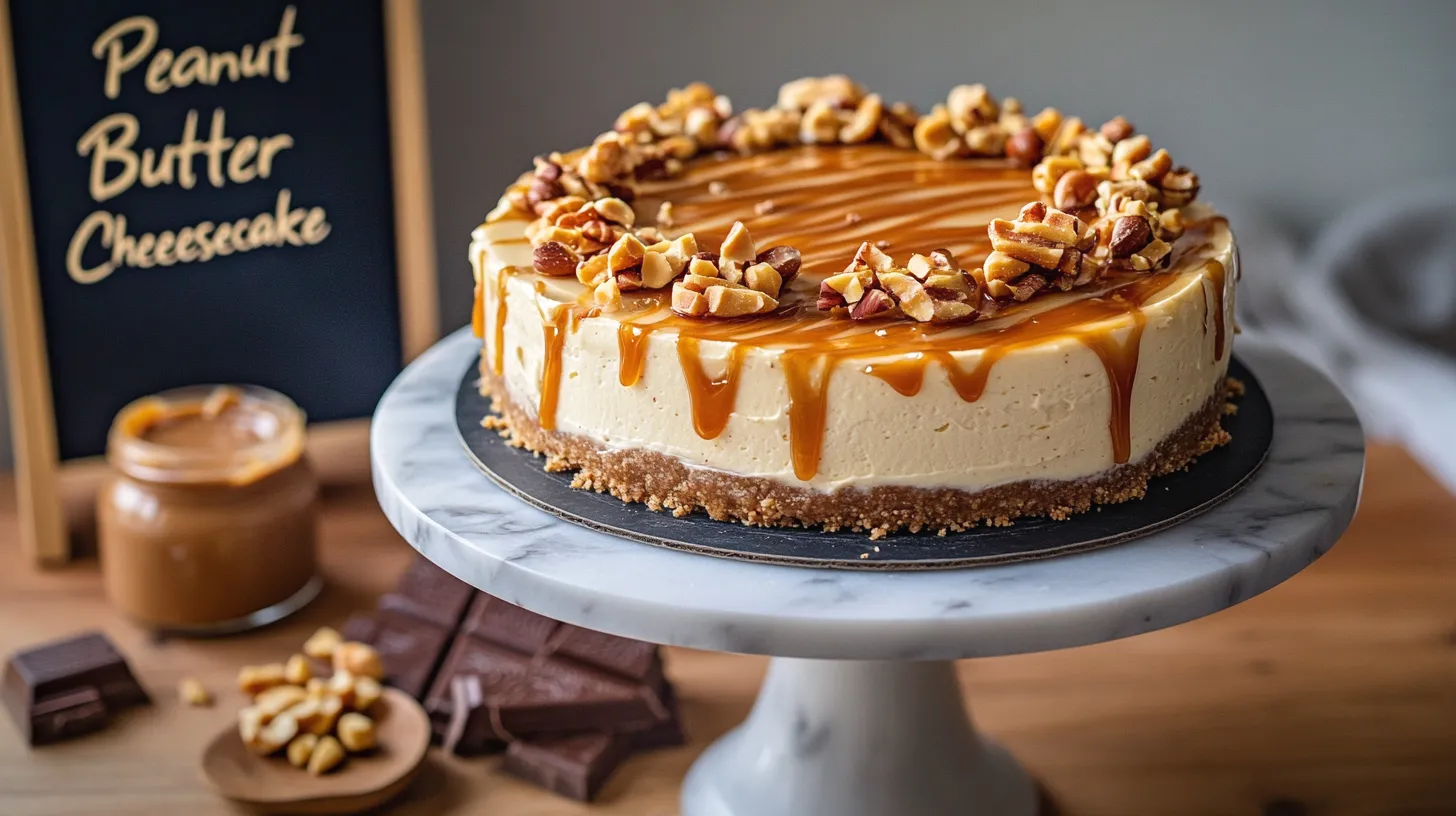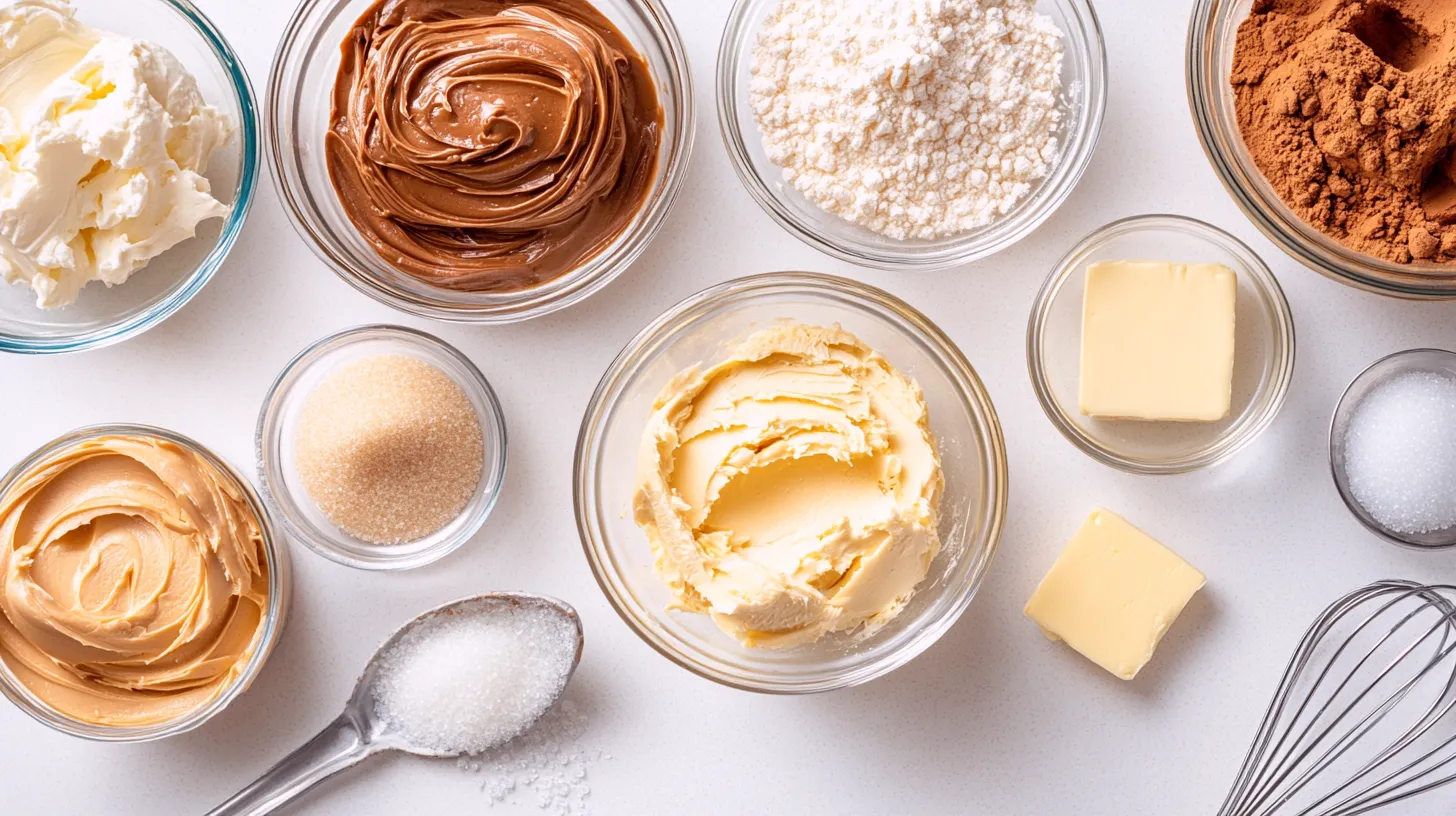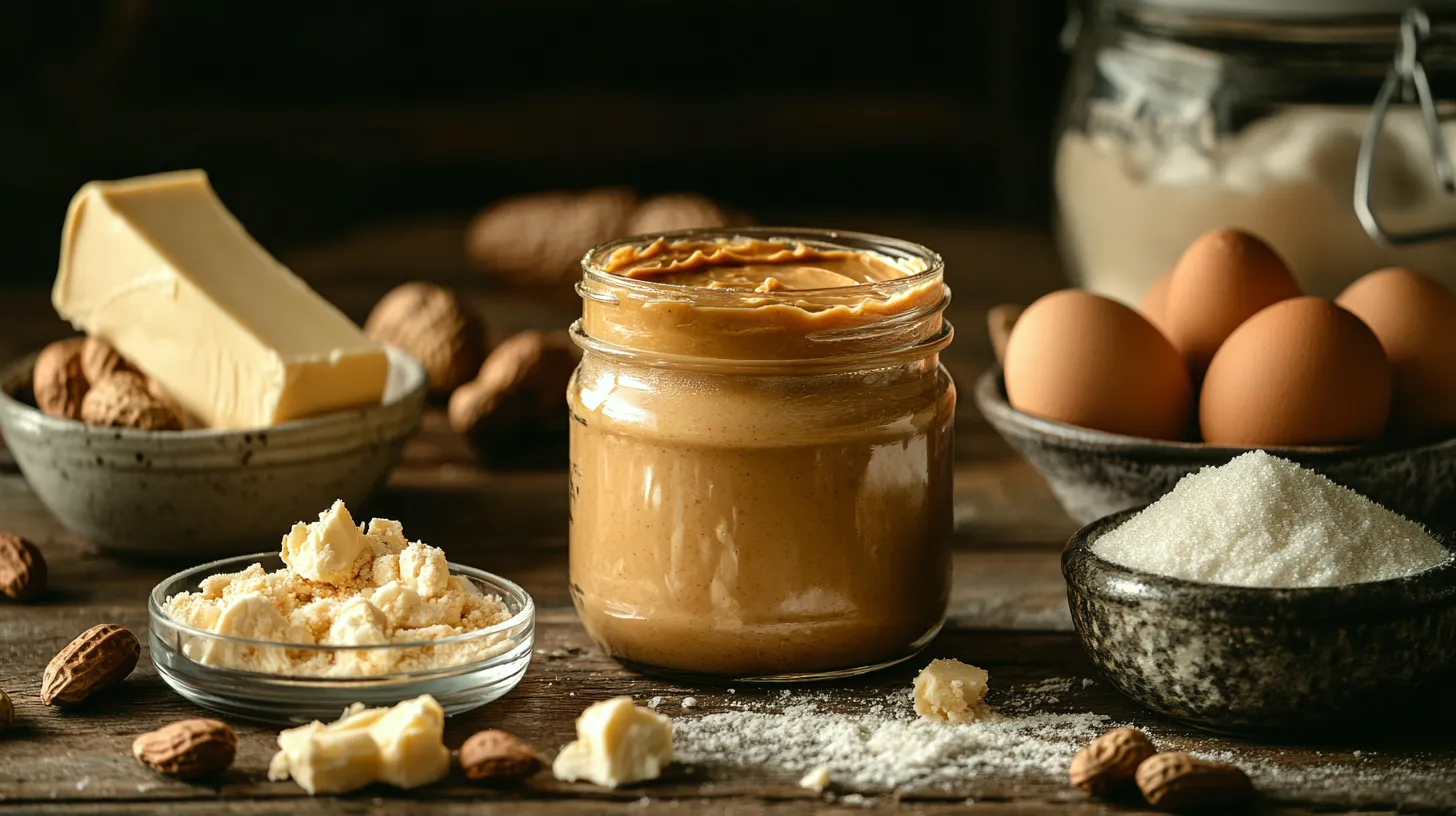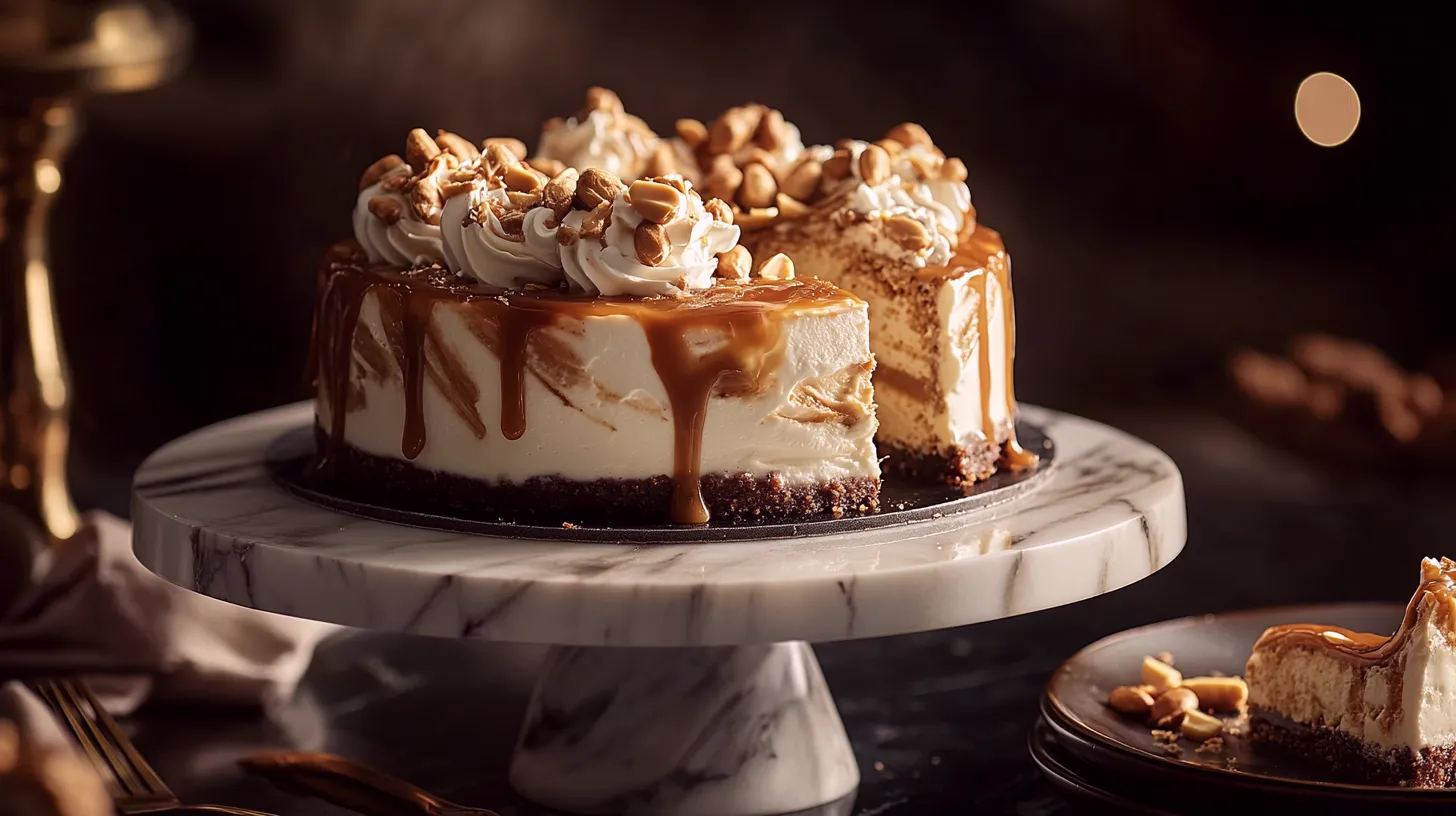
Table of Contents
Introduction to Peanut Butter Cheesecake Recipe
What is Peanut Butter Cheesecake?
Peanut Butter Cheesecake Recipe is a creamy and decadent dessert that combines traditional cheesecake’s rich, tangy flavor with peanut butter’s nutty, slightly salty sweetness. This indulgent treat is made with a base of crushed cookies or graham crackers, a creamy peanut butter-flavored cheesecake filling, and often topped with chocolate ganache, whipped cream, or crushed peanuts for added texture and flavor. It’s a perfect balance of sweet and savory, making it a favorite for dessert lovers.
Key Ingredients for Peanut Butter Cheesecake Recipe
Creating the perfect Peanut Butter Cheesecake requires the right blend of ingredients that deliver its creamy, nutty, and indulgent flavor. While the main ingredients lay the foundation, optional additions allow customization to suit your taste.
Main Ingredients: Peanut Butter, Cream Cheese, and Sugar
- Peanut Butter: The star of the cheesecake, peanut butter provides its signature nutty and slightly salty flavor. Smooth peanut butter is typically used to achieve a silky texture, but crunchy peanut butter can add delightful bits for texture lovers.
- Cream Cheese: Cream cheese is the base of any cheesecake, giving the dessert its creamy and tangy foundation. Full-fat cream cheese is recommended for the most decadent flavor and smoothest consistency.
- Sugar: Sugar balances the tanginess of the cream cheese and the saltiness of the peanut butter, creating a lovely dessert. Granulated sugar is most commonly used, but brown sugar can add a more profound, caramel-like sweetness.
Optional Ingredients: Toppings and Garnishes
- Chocolate Ganache: A glossy layer of chocolate ganache can be poured over the cheesecake for a decadent finish.
- Whipped Cream: Swirls of whipped cream add a light and airy element that contrasts with the dense cheesecake.
- Crushed Peanuts: Sprinkling chopped peanuts on top adds a crunchy texture and enhances the peanut flavor.
- Cookie Crumbs: For additional flavor and visual appeal, use cookie crumbs, like Oreo or graham crackers, as a topping.
- Caramel or Chocolate Drizzle: Drizzle caramel or chocolate sauce over the cheesecake for elegance and extra sweetness.
Choosing the Right Peanut Butter for Your Cheesecake
The choice of peanut butter can significantly influence the flavor and texture of your cheesecake:
- Smooth vs. Crunchy: Smooth peanut butter creates a velvety texture, while crunchy peanut butter adds nutty bits for texture enthusiasts.
- Natural vs. Processed: Natural peanut butter, made without added sugar or oils, provides a purer peanut flavor. However, its oil separation can make mixing slightly more challenging. Processed peanut butter is easier to work with and delivers a consistent texture.
- Sweetened vs. Unsweetened: If using sweetened peanut butter, consider reducing the sugar in the recipe to avoid an overly sweet cheesecake. Unsweetened peanut butter lets you control the sweetness.
Peanut Butter Cheesecake Recipe
This creamy and indulgent Peanut Butter Cheesecake is perfect for peanut butter lovers. It features a rich peanut butter filling, a crunchy cookie crust, and optional toppings for a decadent dessert.

Ingredients
For the Crust:
- 2 cups (200g) crushed graham crackers or chocolate cookies
- 1/2 cup (115g) unsalted butter, melted
- Two tablespoons granulated sugar (optional)
For the Filling:
- 3 (8 oz or 225g each) packages cream cheese, softened
- 1 cup (240g) creamy peanut butter
- 1 cup (200g) granulated sugar
- 1/2 cup (120g) sour cream
- Three large eggs
- One teaspoon of vanilla extract
Optional Toppings:
- Chocolate ganache (made with equal parts heavy cream and melted chocolate)
- Whipped cream
- Crushed peanuts
- Caramel or chocolate drizzle
Instructions
Prepare the Crust:
- Preheat your oven to 350°F (175°C).
- Combine crushed graham crackers (or cookies), melted butter, and sugar in a bowl. Mix until the texture resembles wet sand.
- Press the mixture into the bottom of a 9-inch (23 cm) springform pan, creating an even layer.
- Bake for 8–10 minutes. Remove from the oven and let cool.
Make the Filling:
- In a large mixing bowl, beat the softened cream cheese and sugar until smooth and creamy.
- Add peanut butter, sour cream, and vanilla extract, mixing until fully incorporated.
- Beat in the eggs one at a time, ensuring they are well blended but not overmixed.
Assemble and Bake:
- Pour the filling into the prepared crust, spreading it evenly.
- Place the springform pan on a baking sheet to catch any drips.
- Bake at 325°F (160°C) for 50–60 minutes, or until the edges are set and the center slightly jiggles.
- Turn off the oven, crack the door open, and let the cheesecake cool gradually for 1 hour to prevent cracking.
- Once cooled, refrigerate for at least 4 hours or overnight.
Add Toppings (Optional):
- Spread a layer of chocolate ganache over the chilled cheesecake.
- Add whipped cream swirls, crushed peanuts, or drizzles of caramel/chocolate for decoration.
Serve and Enjoy:
- Slice the cheesecake with a sharp knife (wipe between cuts for clean slices).
- Serve chilled, and enjoy the creamy, nutty goodness!
Step-by-Step Guide to Making Peanut Butter Cheesecake

Making a Peanut Butter Cheesecake may seem daunting, but breaking it down into manageable steps ensures a creamy, decadent result every time. Follow this guide to master the process from crust to the final chill.
Preparing the Crust
- Choose Your Base: Start with crushed graham crackers, chocolate cookies, or your preferred biscuit.
- Mix Ingredients: Combine 2 cups (200g) of crumbs with 1/2 cup (115g) melted butter. If you prefer a sweeter crust, add two tablespoons of sugar.
- Form the Crust: Press the mixture evenly into the bottom of a 9-inch (23 cm) springform pan. Use the back of a spoon or a flat-bottomed glass for a compact, even layer.
- Bake or Chill: For added firmness, bake the crust at 350°F (175°C) for 8–10 minutes, or refrigerate it while preparing the filling.
Making the Filling
- Soften Ingredients: Ensure cream cheese and peanut butter are at room temperature for a smooth mixture.
- Cream the Base: Beat 3 (8 oz or 225g each) packages of cream cheese with 1 cup (200g) of sugar until smooth and fluffy.
- Add Peanut Butter and Sour Cream: Mix 1 cup (240g) of peanut butter, 1/2 cup (120g) of sour cream, and one teaspoon of vanilla extract until thoroughly combined.
- Incorporate the Eggs: Add three large eggs one at a time, mixing gently to avoid overbeating, which can cause cracks during baking.
Baking and Cooling the Cheesecake
- Prepare for Baking: Pour the filling onto the prepared crust, smoothing the surface.
- Optional Water Bath: For an ultra-smooth cheesecake, wrap the bottom of the springform pan in aluminum foil and place it in a larger baking dish. Add hot water to the dish, filling it about an inch high.
- Bake: Bake the cheesecake at 325°F (160°C) for 50–60 minutes. The edges should be set, and the center should slightly jiggle.
- Cool Gradually: Turn off the oven and crack the door open slightly. Let the cheesecake cool in the oven for 1 hour to prevent cracks from forming.
How Long to Chill the Cheesecake for the Perfect Texture
- Initial Cooling: Once the cheesecake reaches room temperature, cover it loosely with plastic wrap or aluminum foil.
- Chilling Time: Refrigerate the cheesecake for at least 4 hours, but overnight is recommended for the best texture and flavor.
- Serving Tip: Before serving, allow the cheesecake to sit at room temperature for 15–20 minutes for a softer, creamier consistency.
Variations of Peanut Butter Cheesecake
Peanut Butter Cheesecake is a versatile dessert that can be adapted to suit different preferences and dietary needs. Here are four popular variations that showcase its adaptability and universal appeal.
No-Bake Peanut Butter Cheesecake
A quick and fuss-free version that skips the oven but still delivers rich and creamy results:
- Crust: Use a no-bake crust made with crushed cookies and melted butter.
- Filling: Combine cream cheese, peanut butter, sugar, and whipped cream to create a light, airy texture.
- Chilling: Refrigerate the cheesecake for at least 4–6 hours or overnight to allow it to set correctly.
- Toppings: Add chocolate ganache, whipped cream, or a drizzle of caramel for extra flair.
This variation is perfect for summer days or when you’re short on time.
Vegan Peanut Butter Cheesecake
For those avoiding animal products, this plant-based version offers all the indulgence without dairy or eggs:
- Crust: Use crushed vegan cookies or oats mixed with melted coconut oil.
- Filling: Blend soaked cashews, coconut cream, peanut butter, and a natural sweetener like maple syrup for a creamy filling.
- Set the Cheesecake: Firm it up in the freezer for a few hours instead of baking.
- Optional Additions: Add melted vegan chocolate or fruit preserves to complement the peanut butter.
This version is both cruelty-free and full of flavor, making it a hit with vegans and non-vegans alike.
Peanut Butter Cheesecake with Chocolate Swirls
Peanut butter and chocolate are a match made in dessert heaven. This variation combines both flavors beautifully:
- Base: Use a chocolate cookie crust for a rich foundation.
- Filling: Prepare the peanut butter cheesecake filling as usual.
- Chocolate Swirls: Melt dark or milk chocolate and drizzle it into the filling before baking. Use a knife or skewer to create swirls for a marbled effect.
- Toppings: Garnish with more chocolate shavings or crushed peanuts for a dramatic finish.
The result is a stunning dessert with visually appealing swirls and a perfect flavor balance.
Gluten-Free Peanut Butter Cheesecake
An excellent option for those with gluten sensitivities or celiac disease:
- Crust: Substitute regular cookies with gluten-free or almond flour mixed with butter.
- Filling: The cheesecake filling is naturally gluten-free, so no modifications are needed.
- Toppings: Stick with gluten-free options like crushed peanuts, caramel, or whipped cream.
- Baking or No-Bake Options: Both methods work well with gluten-free adaptations.
This variation ensures everyone at the table can enjoy the creamy, nutty goodness of Peanut Butter Cheesecake.
Serving and Storing Peanut Butter Cheesecake Recipe

Peanut Butter Cheesecake is a rich and indulgent dessert that deserves proper presentation and care to maintain its texture and flavor. Here’s a guide to serving it like a pro and storing it to enjoy later.
How to Serve Peanut Butter Cheesecake
- Slicing Tips:
- Use a sharp, non-serrated knife for clean slices.
- Dip the knife in warm water and clean it between each cut to prevent sticking.
- Serving Temperature:
- Serve the cheesecake slightly chilled but not icy. To achieve a soft, creamy texture, let it sit at room temperature for 15–20 minutes before slicing.
- Presentation Ideas:
- For extra flair, add toppings like whipped cream, chocolate ganache, crushed peanuts, or a drizzle of caramel sauce.
- In contrast, serve individual slices with fresh fruit or a scoop of vanilla ice cream.
- Accompaniments:
- Pair with coffee, tea, or milk to balance the richness.
- A chocolate or berry sauce drizzle on the plate adds a gourmet touch.
Best Ways to Store Leftover Cheesecake
Refrigeration:
- Cover the cheesecake tightly with plastic wrap or aluminum foil to prevent it from absorbing odors from other foods.
- Store in an airtight container for added protection.
- Refrigerated cheesecake stays fresh for up to 5 days.
Portioning:
- If the entire cheesecake will be consumed later, cut it into slices and store them individually. This makes it easier to grab a single portion when needed.
Avoid Excess Moisture:
- If you notice condensation, keep the cheesecake dry by placing a layer of parchment or wax paper between it and the cover.
Freezing Peanut Butter Cheesecake for Long-Term Storage
Pre-Freezing:
- Chill the cheesecake in the refrigerator until firm before freezing. This helps maintain its texture during storage.
Wrapping:
- Wrap the entire cheesecake or individual slices tightly in plastic wrap. Add a layer of aluminum foil for extra protection against freezer burn.
Storage:
- Place the wrapped cheesecake in a freezer-safe container or zip-top bag. Label it with the date for reference.
- Cheesecake can be frozen for up to 2–3 months.
Thawing:
- Transfer the cheesecake from the freezer to the refrigerator at least 8 hours before serving. For smaller slices, 4–6 hours should suffice.
- Avoid thawing at room temperature, leading to uneven texture or spoilage.
Nutritional Information and Health Considerations
Peanut Butter Cheesecake is a delicious indulgence, but understanding its nutritional profile and exploring healthier options can help you enjoy it responsibly.
Peanut Butter Cheesecake’s Caloric Breakdown
Standard Serving Size:
- A typical slice (1/12th of a 9-inch cheesecake) provides approximately 350–500 calories, depending on the recipe and toppings.
Macronutrient Profile:
- Fat: Peanut butter and cream cheese contribute to the high-fat content, with a single slice containing 25–35g of fat, including saturated fat.
- Carbohydrates: In the filling and crust, sugars add around 30–40g of carbohydrates per slice.
- Protein: Peanut butter offers protein, with a slice containing about 7–10g.
Sugar Content:
- Added sugar contributes significantly, typically 20–30g per slice.
Is Peanut Butter Cheesecake Healthy?
- Benefits:
- Protein and Healthy Fats: Peanut butter contains protein and heart-healthy monounsaturated fats.
- Calcium: Cream cheese provides calcium, supporting bone health.
- Concerns:
- High Calories: The dessert is calorie-dense, making portion control essential.
- Saturated Fats: Cream cheese and butter contribute significant saturated fats, which should be moderated for heart health.
- Sugar Levels: The high sugar content can impact blood sugar levels and overall caloric intake.
Peanut Butter Cheesecake is best enjoyed as an occasional treat rather than a daily dessert.
How to Make Peanut Butter Cheesecake Healthier
- Lower the Calorie Content:
- Use low-fat or reduced-fat cream cheese.
- Replace some peanut butter with powdered peanut butter to reduce fat and calories.
- Reduce Sugar:
- Substitute granulated sugar with natural sweeteners like stevia, erythritol, or a smaller amount of honey/maple syrup.
- Use a Healthier Crust:
- Swap the traditional graham cracker crust for one made with almond flour, oats, or crushed nuts.
- Lighten the Toppings:
- Skip heavy toppings like chocolate ganache or whipped cream.
- Use fresh fruit or a drizzle of dark chocolate instead.
- Increase Nutrient Density:
- Add Greek yogurt to the filling for extra protein.
- Incorporate chia seeds or flaxseeds into the crust for added fiber.
- Portion Control:
- Serve smaller slices to reduce caloric intake per serving.
Frequently Asked Questions (FAQs)
Here are answers to common questions about making, modifying, and perfecting Peanut Butter Cheesecake.
How Do I Prevent My Peanut Butter Cheesecake from Cracking?
- Use Room-Temperature Ingredients: To create a smooth batter, ensure cream cheese, eggs, and peanut butter are at room temperature.
- Avoid Overmixing: Overmixing incorporates too much air, which can cause cracks during baking.
- Bake in a Water Bath: Wrap the springform pan in aluminum foil, place it in a larger pan, and fill it with an inch of hot water to provide even heat distribution.
- Cool Gradually: After baking, let the cheesecake cool in the oven with the door slightly ajar for an hour to prevent sudden temperature changes.
Can I Make Peanut Butter Cheesecake Without a Crust?
Yes, you can! Here’s how:
- Grease the bottom of the springform pan with butter or line it with parchment paper to prevent sticking.
- Pour the cheesecake filling directly into the pan.
- Bake as usual and handle carefully when slicing, as the absence of a crust may make the cheesecake slightly more delicate.
How Long Should Peanut Butter Cheesecake Cool?
- Initial Cooling: After baking, allow the cheesecake to cool in the oven with the door ajar for about an hour.
- Refrigeration: Once at room temperature, refrigerate for at least 4 hours, though overnight is ideal for the best texture and flavor.
Can I Use Peanut Butter Powder for Cheesecake?
Yes, peanut butter powder is a tremendous lower-fat alternative. Here’s how:
- Replace part or all of the peanut butter in the recipe with rehydrated powder. Mix the powder with water to achieve a creamy consistency.
- Adjust sweetness as needed; peanut butter powder is typically less sweet than traditional peanut butter.
Can I Use Almond Butter Instead of Peanut Butter?
Absolutely! Almond butter is an excellent substitute for peanut butter and works well in cheesecake:
- Use the same amount of almond butter as the recipe calls for peanut butter.
- Choose smooth almond butter for a creamy texture or crunchy for added texture.
- Be mindful of the flavor difference, as almond butter has a milder, slightly sweeter taste than peanut butter.
How Do I Make Peanut Butter Cheesecake More Chocolatey?
- Chocolate Crust: Use chocolate cookie crumbs instead of graham crackers for the crust.
- Chocolate Swirls: Add melted chocolate to the filling and swirl it in with a knife before baking.
- Chocolate Topping: Pour a layer of chocolate ganache over the chilled cheesecake.
- Mix-In Options: Fold in mini chocolate chips or chunks of your favorite chocolate into the filling.
- Cocoa Powder: Add 1–2 tablespoons of unsweetened cocoa powder to the filling for a deeper chocolate flavor.
Conclusion
Peanut Butter Cheesecake is a decadent and versatile dessert that can be enjoyed in countless ways, from its classic baked form to creative variations like no-bake or vegan options. Its creamy texture, nutty flavor, and ability to pair beautifully with chocolate and other toppings make it a favorite among dessert enthusiasts. By following step-by-step instructions, mastering techniques to prevent cracking, and exploring healthier or alternative ingredients, you can create a cheesecake that suits any occasion or dietary need.
Whether you serve it at a special gathering, savor it as a personal treat, or experiment with new flavors, Peanut Butter Cheesecake is sure to impress and delight. With proper storage and thoughtful preparation, this indulgent dessert can be a memorable centerpiece or a cherished leftover, ready to satisfy your sweet cravings. Enjoy the process of creating and sharing this decadent treat with loved ones!
Try this recipe tonight and tag us @biscsweet on social media and follow us on Facebook.
